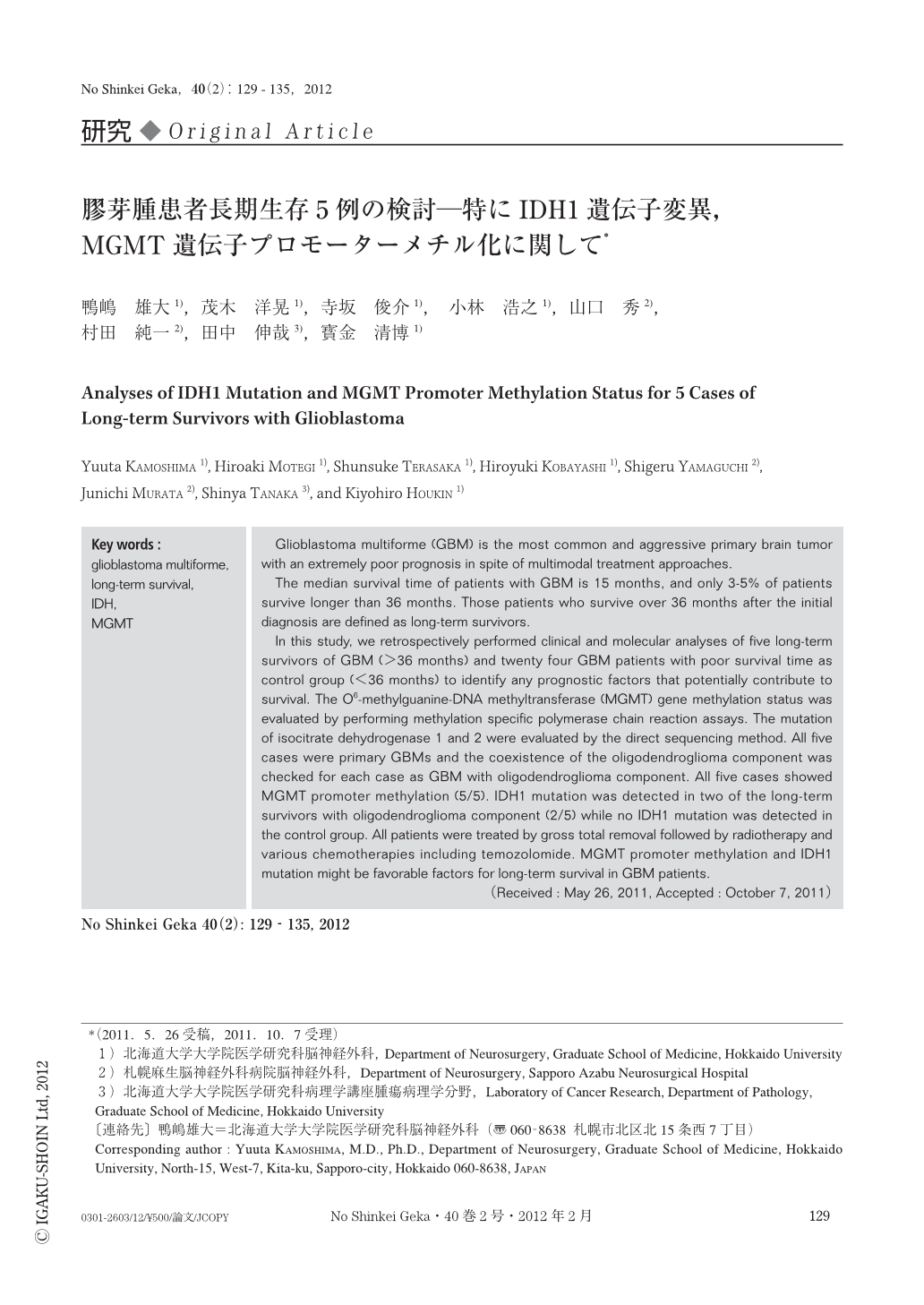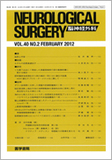Japanese
English
- 有料閲覧
- Abstract 文献概要
- 1ページ目 Look Inside
- 参考文献 Reference
Ⅰ.はじめに
多形膠芽腫(glioblastoma multiforme:GBM)は,成人の原発性脳腫瘍の中でも頻度が高く,かつ極めて悪性度の高い腫瘍型である.現在の標準治療である,外科摘出,テモゾロミド(temozolomide)化学療法,放射線治療を組み合わせた集学的治療を行った場合でも,全生存期間中央値は15カ月程度であり,人体に発生する他臓器の悪性腫瘍と比較しても,その予後はいまだ不良である14,15).
GBMと診断されたほとんどの患者が36カ月以内に死亡するのに対し,36カ月以上の生存期間を示す長期生存GBM患者も3~5%と少数であるが認められる.これまで,GBM患者における臨床的予後因子として,発症時年齢,診断時Karnofsky Performance Status(KPS)が関連することが報告されており4),さらに近年では分子生物学的予後因子同定のため,TCGA(The Cancer Genome Atlas)に登録されたGBM症例に対して膨大な数の遺伝子変異解析が行われている.
これまで臨床的にGBM患者の治療反応性(予測因子)および予後を予測し得るバイオマーカーとして認知されているものはごくわずかであり,代表的なものとしてO6-methylguanine methyltransferase(MGMT)遺伝子プロモーターメチル化,isocitrate dehydrogenase(IDH)遺伝子変異が挙げられる.
2005年にHegiらによって報告されたGBMにおけるMGMT遺伝子のプロモーターメチル化は,テモゾロミドやニトロソウレアなどアルキル化製剤の使用下において,MGMT遺伝子がエンコードするDNA修復タンパクの発現に関与することで,GBM患者の予後に影響するものと考えられている7,9).
また2009年には,Yanらがクエン酸回路におけるイソクエン酸(isocitrate)からアルファケトグルタル酸(α-ketoglutarate)への反応を触媒する酵素であるイソクエン酸脱水素酵素(isocitrate dehydrogenase)をエンコードするIDH遺伝子の変異が,GBMをはじめとする神経膠腫に特異的に認められ,加えて同遺伝子に変異(mutation)を有する群が野生型(wild type)に比較し,予後良好であったことを報告した17).
GBM長期生存患者におけるこれらの予後に寄与し得る各遺伝子変異(修飾)の意義は,長期生存GBM患者自体が少数であることからも,いまだ不明な点が多い.今回われわれは,基本的臨床データに加えて,上記2種のGBMバイオマーカーに関する検討を,臨床的にprimary GBMと診断され,当科で治療後36カ月以上の長期生存を示した5例を対象に行った.また,症例は少ないが,当科で経験した予後不良群24例とのバイオマーカーを中心とした比較検討を行った.
Glioblastoma multiforme (GBM) is the most common and aggressive primary brain tumor with an extremely poor prognosis in spite of multimodal treatment approaches.
The median survival time of patients with GBM is 15 months, and only 3-5% of patients survive longer than 36 months. Those patients who survive over 36 months after the initial diagnosis are defined as long-term survivors.
In this study,we retrospectively performed clinical and molecular analyses of five long-term survivors of GBM (>36 months) and twenty four GBM patients with poor survival time as control group (<36 months) to identify any prognostic factors that potentially contribute to survival. The O6-methylguanine-DNA methyltransferase (MGMT) gene methylation status was evaluated by performing methylation specific polymerase chain reaction assays. The mutation of isocitrate dehydrogenase 1 and 2 were evaluated by the direct sequencing method. All five cases were primary GBMs and the coexistence of the oligodendroglioma component was checked for each case as GBM with oligodendroglioma component. All five cases showed MGMT promoter methylation (5/5). IDH1 mutation was detected in two of the long-term survivors with oligodendroglioma component (2/5) while no IDH1 mutation was detected in the control group. All patients were treated by gross total removal followed by radiotherapy and various chemotherapies including temozolomide. MGMT promoter methylation and IDH1 mutation might be favorable factors for long-term survival in GBM patients.

Copyright © 2012, Igaku-Shoin Ltd. All rights reserved.


